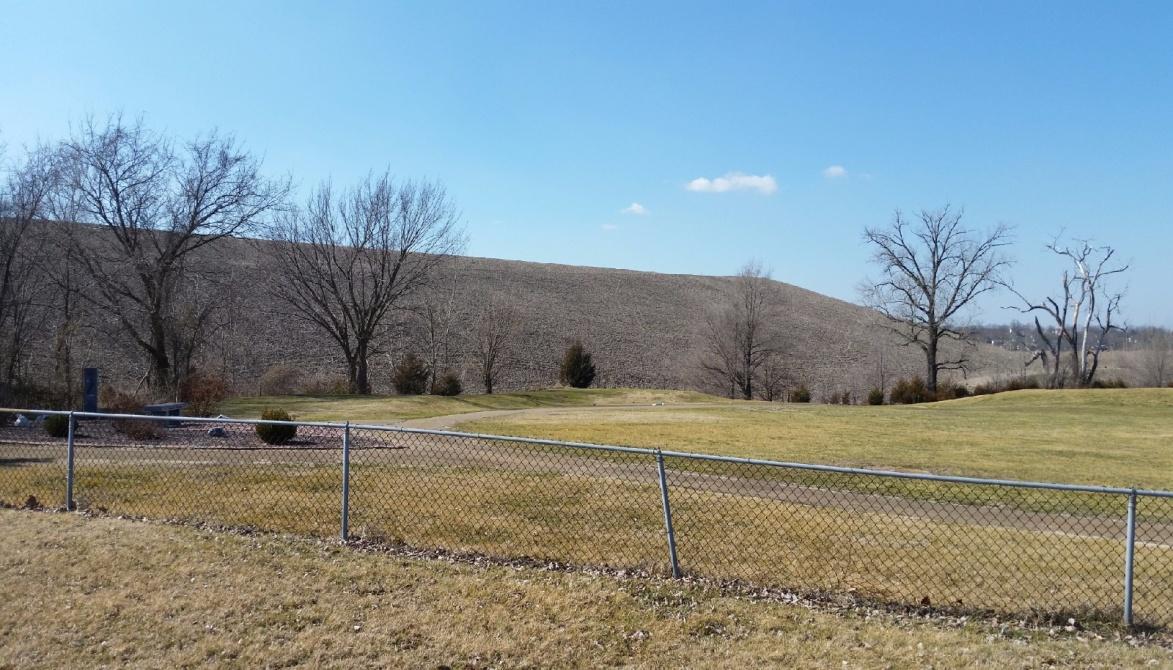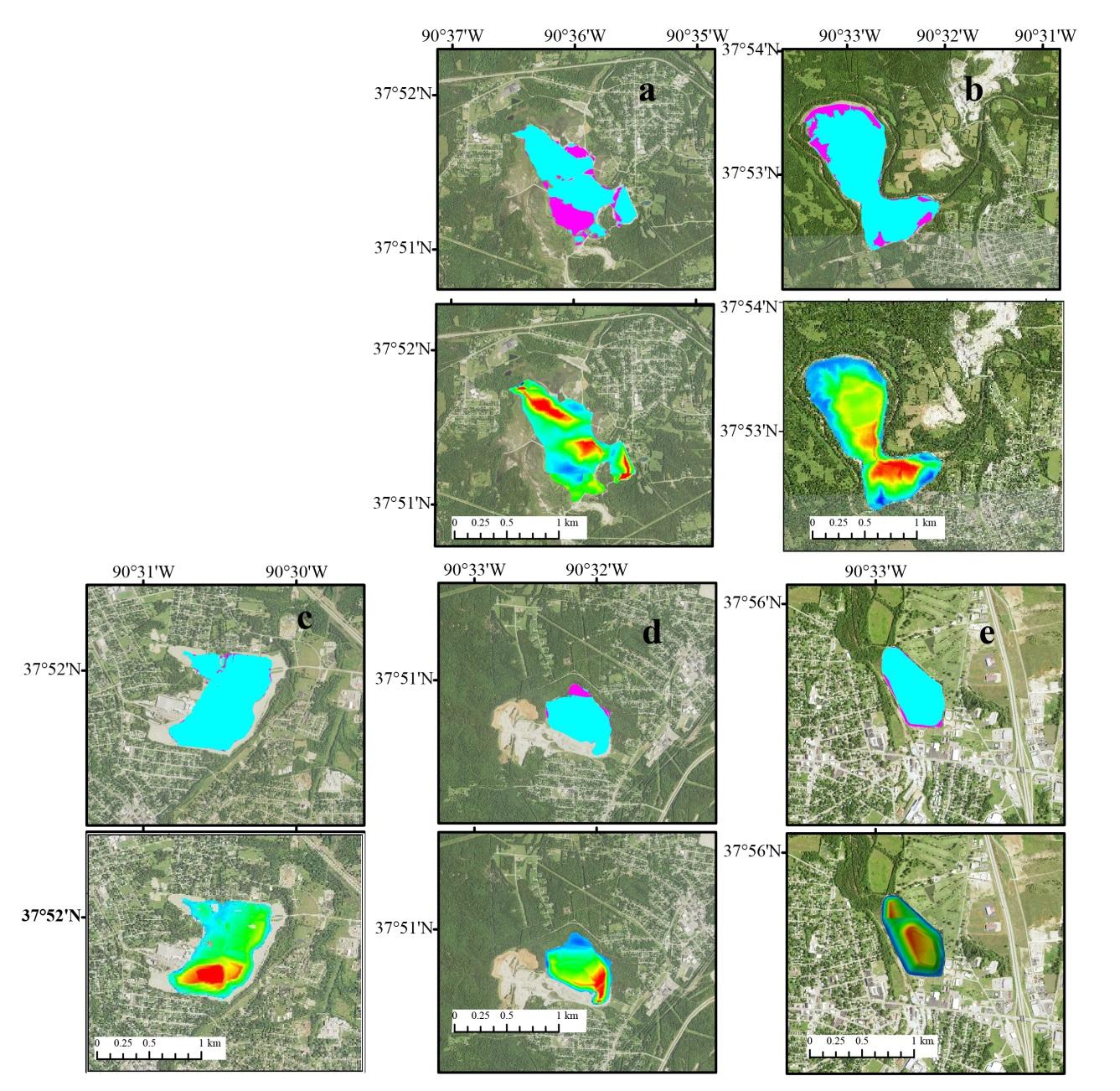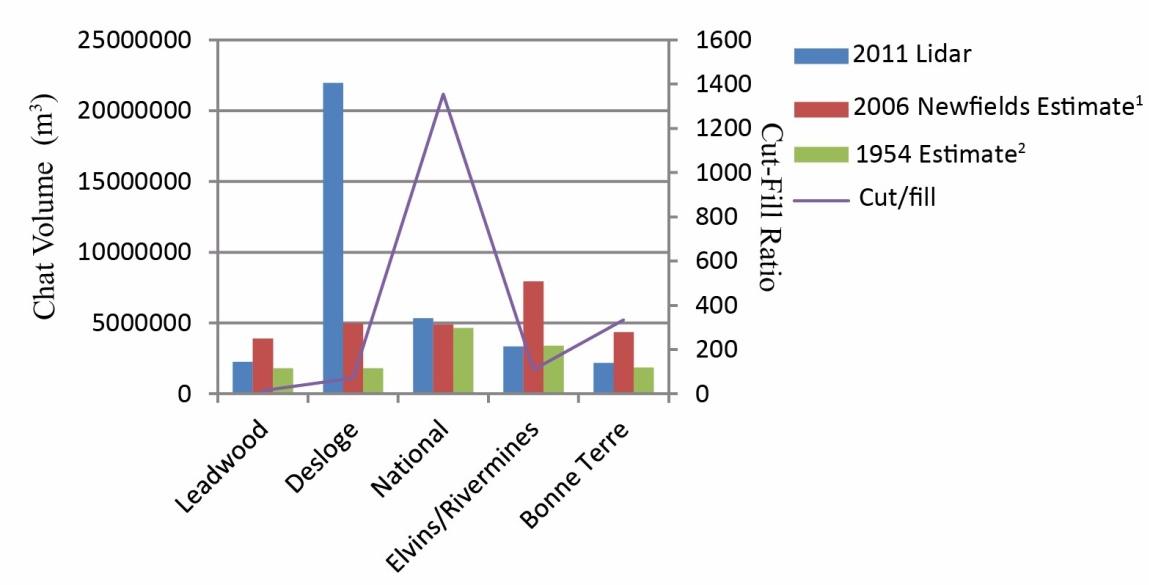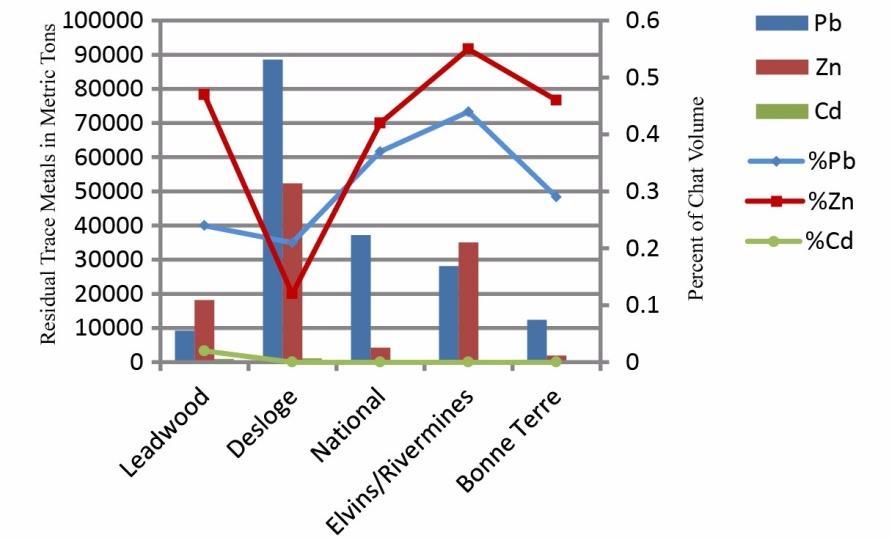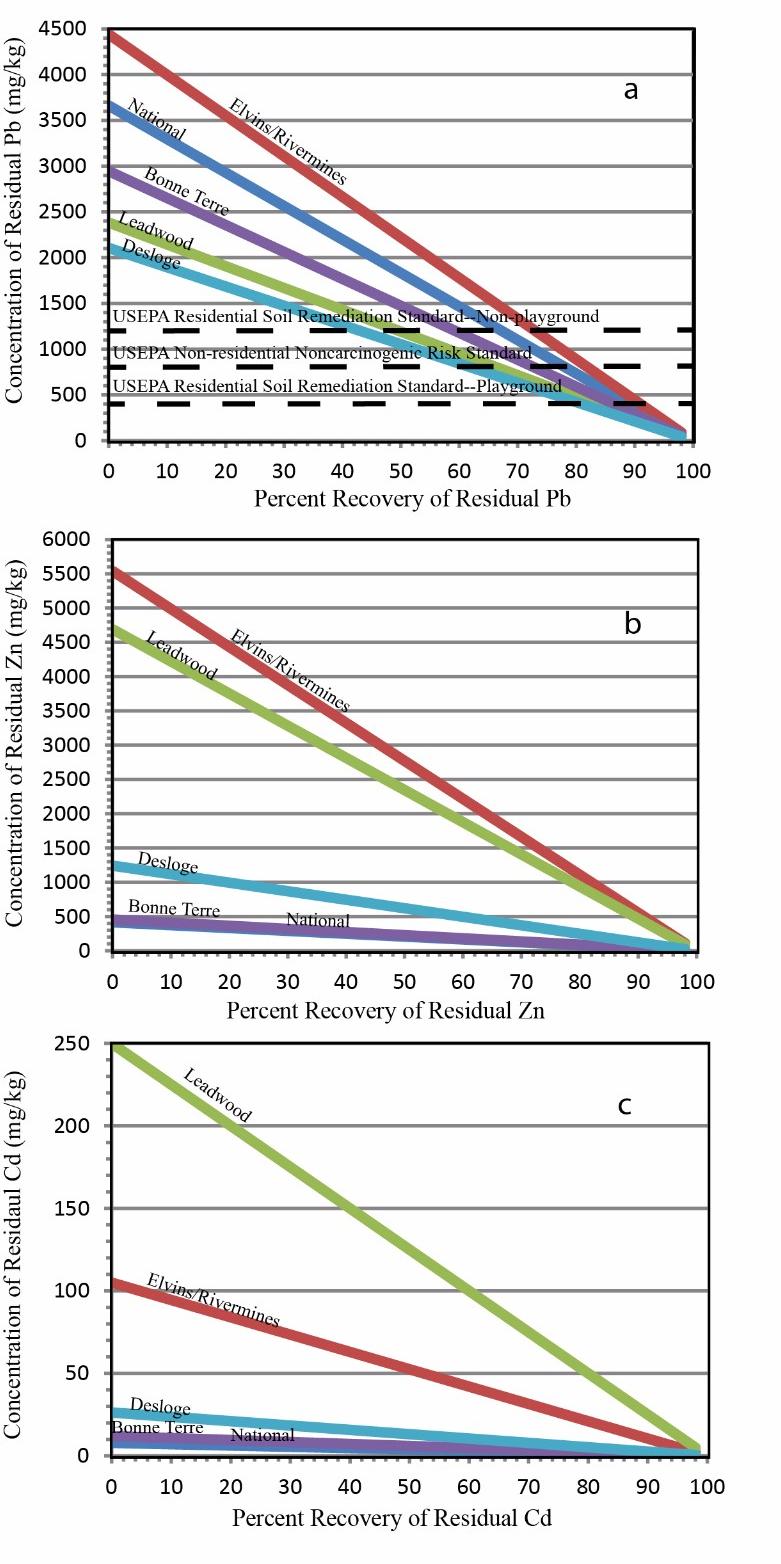1. Introduction
Lead and zinc have been important resources of human existence for thousands of years, but the global industrial revolution of the last 250 years has been the driving factor in its increased production and resulting waste load. From the mid-1800s to the early 1970s, mining in the United States has produced millions of tons of lead-zinc ore. The piles of gangue and processing waste from beneficiation used to extract the Pb and Zn sulfides from host rock currently exist in every region where there has been a history of mining activity. These piles have risen more than 100 m above the surrounding landscape representing landmarks of a region’s mining history. Unfortunately, this waste gangue has created human health and environmental concerns leading to millions of dollars in clean-up costs and a legacy of lead-related health issues such as cognitive development in children[1,2,3,4,5]. Current clean-up methodologies often do not remove this material from the site. Remediation is often limited to slope stabilization and vegetation or gravel cover to reduce contaminant transport [6]. While this has substantially mitigated much of the erosion and wind-blown transport of the finer Pb-laden material from these piles, the problem of residual trace metals remains.
Estimating the amount of this waste material for additional remedial purpose has been restricted to extensive site investigations traditionally involving core sampling for physical and chemical analysis and topographic surveying to determine volume and surface area. While there are no remote methods for obtaining physical samples to characterize the physical and chemical quality of this material, light detection and ranging (lidar) data are becoming available and can substantially reduce the labor of collecting elevation point data in the field for volumetric estimation. Lidar is a remote sensing capability deployable on manned and unmanned aircraft that uses laser light representing a very narrow bandwidth (near infrared) to obtain geospatially referenced 3-dimensional points of the land surface and other terrestrial objects. Currently the Federal Government is collecting lidar data to improve the source datasets used to build digital elevation models (DEM) and to provide these data for multiple uses [7]. The U.S. Geological Survey 3D Elevation Program (3DEP) lidar data are publicly available in both their native point cloud format and as derived products such as DEMs.
Volumes of mine waste piles are traditionally estimated using a number of other resources including historic DEMs from the U.S. Geological Survey (USGS), stereo-paired imagery interpretations, and limited field measurements of elevation. While these methods are acceptable for providing quick estimates of remaining volumes, they lack accuracy inherent in the resolution of available data. For example, source data for the legacy USGS 10 and 30 m DEM products were largely built from historic contour data, and these data could represent a time when the piles were higher, lower, or non-existent. Stereo-paired imagery may not represent the time frame of interest depending on when the imagery was acquired, and field measurements using traditional topographic survey methods with high precision instruments (i.e., Real Time Kinematic GPS) are limited to a few economically reasonable number of data points.
This investigation demonstrates that estimates of residual trace metal content of mine waste piles can be computed using the publicly available lidar source data. Using five mine waste piles located in the Old Lead Belt of Missouri, this effort: 1) uses lidar point cloud data to calculate volumes of each pile and compares those with previous estimates, 2) uses the resulting volumes to calculate residual Pb, Zn, and Cd content, and 3) determines the mitigation goals that uses the resulting volumes and available metal analysis data to bring the mine waste into compliance with Federal human-health and environmental standards. The lidar estimated trace metal content of chat piles can provide reliable and useful information for the research community to set goals for developing new trace metal recovery techniques that mitigate trace metal concentration to levels that render the waste safe for other beneficial purposes.
2. Methods
2.1. Description of study area
The study area is located in St. Francois County, Missouri, which is part of the Old Lead Belt of the Southeast Missouri Lead Mining District (Figure 1). Historic lead ore extraction ranked number two in the Nation with approximately 7,700,000 metric tons being produced from 1864 to 1972 [8]. Extensive mining in the Old Lead Belt resulted in several mine waste piles composed of tailings, chat, development rock and other mine waste (hereinafter referred to as chat piles). Some of the resulting chat piles were re-milled when newer floatation technologies came online, resulting in the re-addition of large quantities of slime waste to the piles and surrounding basins. These large tailings piles became landmarks for southeast Missouri communities with tan-colored hills rising above the horizon always reminding the population of the region’s mining past (Figure 2).
2.2. Elevation source data
The lidar data used for this investigation reside within the USGS 3D Elevation Program (3DEP) database (http://viewer.nationalmap.gov/basic/). The 3DEP is a national-level program managed by the USGS to systematically collect lidar and Interferometric Synthetic Aperture Radar (ifsar) as source data for creating high resolution digital elevation products. This program includes data from the National Elevation Dataset (NED) repository comprising seamless digital elevation models (DEM) for the United States. The seamless layers (2, 1, 1/3, and 1/9 arc-second) represent products developed by a variety of historic production methods that do not exclusively include either lidar or ifsar as source data. The goal of 3DEP is to complete U.S. coverage with new source data over an 8-year period which, began in 2014[9,10]. Currently, nearly half of the country has available lidar data, but the quality and specifications used for collecting these data vary considerably and the coverage is limited. The 3DEP was developed to provide guidance for future collections of lidar, ensure partnerships are established that encourage leveraged funding for collection, and to maintain an internal quality assessment process for source data and products that are publically distributed through the 3DEP database.
Specifications for the collection of new lidar source data are contained in a USGS Techniques and Methods report that is updated at least once every two years [11]. Lidar data are potentially collected at four quality levels (QL) (0-3) with the minimum acceptable level for new collection at QL2. The QL2 data are characterized as having an aggregate nominal pulse spacing of≤0.71 m and an aggregate nominal pulse density of≥2 points/m2. The 3DEP database currently has a large quantity of QL3 data available for use by the science and engineering community. The QL3 product is characterized as having an aggregate nominal pulse spacing of≤1.4 m and an aggregate nominal pulse density of≥0.5 point/m2. The absolute vertical accuracy of the QL2 and QL3 unclassified swath data is≤10 and≤20 cm RMSEz, respectively, for non-vegetated open areas where statistical comparison is calculated using independently surveyed vertical control checkpoints. The USGS recommends that users of the data check vertical accuracy using local vertical control to ensure the data meet the needs of a particular project. Separate vertical accuracy checks are not necessary for volumetric calculations and were not done for this investigation. QL2 source data currently support the development of 1m resolution digital elevation models and QL3 will support a 2 m cell size. DEMs are delivered as a derived product from the lidar data, undergo extensive quality assessment by the USGS, and are distributed through The National Map as LAS files [12]. A LAS file is an industry-standard binary format for storing lidar data[11].
Lidar data used for this analysis were downloaded as LAS version 1.2 files from the USGS 3DEP database through The National Map. The data are QL3 having been collected from January through February of 2011. The collection specifications for the four published tiles of data include a pulse spacing range of 0.831 to 0.977 m and a pulse density range of 1.046 to 1.175 points/m2. The fundamental vertical accuracy for these data computed from 20 independently surveyed checkpoints representing open non-vegetated ground is 17.89 cm. The data include four discrete returns that have been processed into five classes including unclassified (1), ground (2), low noise (7), water (9) and reserve points (11). Mine chat and tailings in St. Francois County are open areas with minimal vegetation; therefore, first return points classified as ground dominated the data used for volumetric analysis.
Quantification of chat pile volume was accomplished using ESRI ArcGIS and Qcoherent LP360 lidar software. A base polygon for each pile was assembled as a shapefile using the editing tools in ArcGIS. Then each shapefile was conflated with lidar elevation points within proximity of each vertex of the polygon. The new conflated polygon set the base elevations for the volume calculation. Using LP360, a point cloud task macro was developed to compute cut and fill areas, volume, and build a new LAS dataset with all points classified as ground.
2.3. Chat trace metals
The concentrations of Pb, Zn, and Cd were quantified for six tailings piles in the Old Lead Belt region of Missouri by [13], with summary data presented in [14]. These six tailings piles include the historic lead mine working of Leadwood, Desloge, National, Elvins/Rivermines, Bonne Terre, and Federal. All six piles have undergone partial or complete remediation, which has included: redistribution of tailing material onsite to reduce slope angles to minimize rill erosion; berm development to reduce riparian transport of fine materials and re-vegetation. The Old Lead Belt chat piles have long been an environmental concern for southeastern Missouri as many of these mines began their workings in the 18th century. Unfortunately, because of the close proximity of these chat piles to streams, the resulting release of this material has allegedly resulted in adverse effects to the local biota [14,15].
For this analysis, 5 of 6 chat piles for which trace metals data exist were used to quantify residual trace metal concentration. The Federal chat pile was not quantified, because much of the tailing material is contained within the impoundment of Shaw Branch and a substantial portion of the original pile has been distributed onsite within this impounded area and re-vegetated. Therefore, developing a reasonable base polygon for volumetric calculation was not possible.
The trace metal data provided by [13] represent average concentrations of numerous samples collected from the surface tailing of each pile. The Leadwood, Desloge, National, Elvins/Rivermines, and Bonne Terre tailings piles each represent average concentrations calculated from 108, 74, 96, 92 and 88 samples, respectively [14]. The extensive analysis of these tailings and quality assurance performed through regulatory actions precludes the need for additional sample collections for this analysis.
3. Results and Discussion
3.1. Chat pile volumes
Estimating the quantity of material remaining in a chat pile can involve extensive field labor that generally includes topographically measuring elevation using a survey-grade Global Navigation Satellite System (GNSS) and Real Time Kinematics (RTK). Lidar sensors also use the GNSS and RTK systems, but collection error is substantially reduced by employing an Inertial Measuring Unit to correct for sensor movement. Holding the GNSS receiver rod level during traditional topographic surveys is a source of uncorrectable error.
Using lidar that has already received quality assessment can minimize the need for this field labor. Field labor may still be required to obtain samples needed to characterize the average trace metal concentration, and chat volume-weight parameters if these data have not already been collected for other efforts. In almost all cases, engineering-specific physical properties of the chat will need to be obtained; however, this effort was limited to general soil property classifications for chat-like material contained in the literature [16].
The lidar used for this investigation provided substantially more elevation points of the chat pile surface than what could efficiently be collected using traditional field topographic survey methods. For example, the number of vertical elevation points ranged from 123,362 to 1,387,023 for the five chat piles as delineated using an image-derived base polygon (Table 1). By comparison, estimated labor hours per point for field-acquired elevations is about 3 minutes, assuming the GNSS equipment has an acceptable positional precision of dilution and that the GPS solution is within acceptable statistical criteria. This does not include transit time between measurable surfaces. Therefore, lidar data provide a considerable reduction in data acquisition time, improving the densification of point clouds.
Table 1.Volume and residual trace metal content data for five chat piles in the St. Francois County, Missouri.
| Chat Pile | Base Area (m2) | Number of Elevation Points | Hull Area (m2) | Adjusted Chat Volume as of 1/2011 (m3) | Cut-fill ratio | Chat volume-weight estimate2 (kg) | Residual Pb1 (Metric Tons) | Residual Zn1 (Metric Tons) | Residual Cd1 (Metric Tons) |
| Leadwood | 897,799 | 667,629 | 903,722 | 1,970,498 | 14.6 | 1970 | 9247 | 18,210 | 970 |
| Desloge | 1,906,433 | 1,387,023 | 1,939,643 | 21,360,577 | 71.8 | 1970 | 88,579 | 52,306 | 1107 |
| National | 595,568 | 429,932 | 610,810 | 5,153,361 | 1355 | 1970 | 37,167 | 4233 | 80.2 |
| Elvins/Rivermines | 398,524 | 286,983 | 407,129 | 3,211,752 | 109 | 1970 | 28,093 | 35,059 | 664 |
| Bonne Terre | 166,856 | 123,362 | 172,319 | 2,138,597 | 334 | 1970 | 12,407 | 1925 | 50.6 |
1 Concentration data used for calculations are from [13].
Based on USCS ML soil representing tailings as sandy, clay and silt fines with liquid limit less than 50%. Average quantity determined from NAVFAC 7.01 soil properties index, which places the density in the 100 to 147 lb/ft3 range. |
The chat pile volumes presented here represent a single period in time around January 2011. Additional remediation and redistribution of chat material could have occurred since this analysis. Similar remedial efforts for chat piles in the Tri-State Mining District have resulted in variable volumes being calculated using lidar and DEM data over a period of 5 years [17]. Remediation that occurred prior to this analysis included covering the redistributed chat material with a 0.5-1.0 m layer of quarry dolomite. The purpose of this application is to keep dust from migrating off site due to wind and water erosion and to limit access to the chat piles by off-road vehicles and pedestrians. Cover material consisted of 7 to 13 cm size stone that was acquired locally. While lidar data are not routinely collected over a region creating a temporal dataset, the technology to collect one-off lidar and photogrammetric flights using unmanned aerial systems has become an inexpensive method [18]. Such systems can be used to build temporal datasets over small areas undergoing remediation.
Chat volumes ranged from 2 to 22 million cubic meters with the remaining pile at Desloge representing the largest (Table 1). Volumes were calculated relative to a base polygon that was derived from 1m National Aerial Imagery Program data of the same collection vintage using visual inspection techniques. Only areas near the pile with the same bright reflectance were included in the base polygon. A profile tool was used to check material elevations at each chat pile relative to ground points in adjacent forested areas to validate the delineation process. The volume extraction characteristics of each chat pile varied slightly between piles, largely related to the base polygon. The assumption is that the base polygon represents, as close as possible, the original land surface elevation of the chat pile location.
The Leadwood chat pile had the lowest cut-fill ratio (14.6) indicating there is substantial contouring and redistribution of the pile onsite and within the tailings basin fill area of Eaton Branch. Figure 3a clearly shows that portions of the basin fill area used for storage of processed tailings was not included in the base polygon because the area represented a topographic depression relative to the chat pile. For chat piles with similar geographic characteristics, this base delineation approach could increase the error in determination of residual trace metals. Therefore, it is recommended that when such conditions are observed in the dataset, field verification of the delineated base area is necessary. A process for minimizing fill areas in the volume computational area is to refine the base polygon to fit cut areas only. This process may require several iterations but will improve volume estimates.
The Desloge chat pile represents the largest of the five piles reviewed for this investigation. Also, this pile has been substantially remediated because of its proximity to the Big River and past noncompliance issues. The remedial action consisted of re-grading steep slopes, stabilizing slopes with rip rap, constructing sediment traps, and revegetation [14]. The highest elevations of the delineated pile occur in the southern portion of the base area. The cut-fill ratio (71.8) is reasonable with respect to the selection of the base polygon (Figure 3b).
The National chat pile had been recontoured with material distributed onsite in low areas. Also, some of the mining-related buildings appear to be constructed on top of chat that was redistributed into low areas. These redistribution areas were included in the base polygon determination. The cut-fill ratio is large (1355) for the National pile. This is an example of a refined base accomplished through iterative cut-fill computations (Figure 3c).
The Elvins/Rivermines chat pile has been recontoured to prevent erosion of trace metal laden materials. This area was more complex because of a rock quarry adjacent to the chat pile, which made it difficult to delineate between where the chat ended and quarry began. Several iterations of cut-fill calculations were needed to establish a representative base polygon for volume calculation. All drainage on this site is conveyed to the north into a settlement catchment. Some excavation of chat material is evident at the southern portion of the pile, which appears to be an ongoing activity (Figure 3d). Removal of material from the site will influence trace metal residual calculations. It should be noted that the adjacent quarry was established to provide aggregate cover material for this chat pile as part of the required remedial process.
The Bonne Terre chat pile is contained within a smaller area, which made it the least difficult pile to build a base polygon (Figure 3e). Fill areas occur close to the base which is characteristic around these chat piles. No cut-fill iterations were needed to refine the base polygon for this chat pile.
Because all the chat piles have been remediated with quarry stone covering, this material needs to be accounted for in the trace metal residual computation. Records are not publicly available showing the as-built remediation for each pile, so an estimate of covering is used based on oral communication from the Missouri Department of Natural Resources (2016). This estimated cover volume was subtracted from each pile total volume by using the lidar-generated surface area (hull) for each pile multiplied by an average cover depth of 0.3 m. Volumes presented in Table 1 have been adjusted for the surface covering of quarry stone.
Comparison of the lidar-generated volume estimate with historic estimates shows substantial variations (Figure 4).The estimate provided by the current mine owner in 1954 represents a time when ore production was at its peak with much of the chat present today not yet having been deposited. The Newfields [13] estimate was probably built from a combination of legacy DEMs, imagery, and a few field-measured elevations. These volumes represent a time before remediation was completed where some of the material may have been removed from the site. The Desloge chat pile had the largest calculated difference from the two earlier estimates. The extensive regrading and redistribution of chat material during remediation would have made it difficult to estimate the volume of this pile without extensive field measurements and/or lidar. Therefore, the large volume calculated during this investigation is a better representation of the remaining material. The National chat pile had a volume similar to the previous two estimates suggesting that this pile was well contained and did not change substantially. Leadwood, Elvins/Rivermines, and Bonne Terre lidar volume estimates were all smaller than the Newfields [13] estimates, but slightly larger than the 1954 estimates. This is probably the result of post-Newfields remediation efforts in addition to lower resolution datasets used for estimation.
3.2. Residual trace metals
The Old Lead Belt chat piles represent a history of ore processing techniques that has had a substantial influence on the residual trace metal content. Historically, early ore processing was done by crushing ore to separate galena crystals from the gangue then shaking to gravity separate the lead from the host rock. This was an inefficient process for lead recovery but at the time was the only processing technology available. Consequently, early formation of the chat piles contained a higher residual content of lead resulting from the incomplete removal of lead from the host dolomite rock. By the early 1900s, the froth flotation technique, initially patented by William Haynes in 1869, was introduced allowing greater recovery during ore processing [19]. A 1934 film produced by the St. Joseph Mining Company reported lead processing recovery from ore as 3.8% from gravity separation, 1.5% from froth flotation, with remaining mining waste (chat) at 94.5% of the total [20]. The froth flotation process resulted in a finer material (tailings) being added to the chat piles with less residual lead. Current ore processing wastes are tailings size material that is pumped to settling basins minimizing transport of wind-blown contaminated dusts.
The trace metal concentrations obtained by Newfields [13] represent total concentration of surficial chat pile and tailing materials. Also core samples were collected from the National chat pile in 1992 to characterize the content in order to test a newer beneficiation method [21]. Chemical analyses of these samples showed large variations in trace metal concentration with depth. Additional samples to characterize each pile with depth would be cost prohibitive and now that these piles have been re-contoured and stabilized, there is no benefit to this additional effort.
Results of this analysis show residual Pb and Zn in chat to be consistent with current and past beneficiation methods where < 0.5% is typically unrecoverable [22]. Residual Pb ranged from 9247 to 88,579 metric tons for the Leadwood and Desloge chat piles, respectively (Table 1,Figure 5). Although the Desloge chat pile had the largest residual Pb content with 88,579 metric tons, the residual relative to the quantity of chat was the lowest at 0.21%. The largest percent of unrecovered Pb was found in the Elvins/Rivermines pile (0.44%). Most of the milling of ore was consolidated at this site around 1909 and continued until its closure in the 1940s [23]. Milling likely included gravity separation only and at a later date newer combined technologies; therefore, it is expected this chat pile would have the larger residual Pb content. The National chat pile had the second largest residual Pb content of the five investigated. This pile also contained the second largest percent of unrecovered Pb relative to volume. Of the five chat piles investigated, considering the Elvins/Rivermine and National chat piles for reprocessing may be warranted if new economical beneficiation technologies are developed. Lesser consideration could be given to the Leadwood and Bonne Terre chat piles as the residual only account for 0.24 and 0.29%, respectively, and residual quantities are the smallest (Figure 5).
Zinc is milled and processed using the same methods for lead; however, the initial content of zinc in ore is only about 1%. Both the Leadwood and Elvins/Rivermines chat piles had a larger residual content of zinc. In addition, both had a larger percent content relative to total volume of these chat piles (Figure 5). By contrast the National and Bonne Terre chat piles had substantially smaller residual content of Zn, yet the percent of Zn relative to the total volume of chat material was larger than that observed for Pb.
Current economical quantities of Pb and Zn range from 3 to 10% for lead sulfides and about 1% for zinc sulfides. Since chat represents a pre-milled quantity of material with known residual content that is centrally located, new beneficiation methods could make re-milling/processing these wastes for trace metals economical. Economic recovery results from not having to extract and transport raw ore from the mine, reduced effort for crushing of chat versus ore, and overall less labor costs. The byproducts of reprocessing would be expected to have lower residual trace metal content, which would support multiple beneficial uses of the remaining waste material.
3.3. Recovery estimation
The benefit of calculating residual trace metal content of the existing chat piles is to provide the research engineering community with a goal for developing processes and/or techniques to further recover these constituents. Going forward with newer recovery techniques, there are two potential uses for the re-milled chat material—1) recoverable Pb and Zn that can be further processed into the respective elemental forms for use by industry, and 2) waste rock containing residual trace metal concentration below Federal standards for health and safety that can be safely used as a soil amendment in the agricultural industry. The ultimate goal is to remove these chat piles from the southeastern Missouri landscape by creating a beneficial use for the material and eliminating the potential health concerns from erosion and wind-blown waste in the area.
Three Federal soil standards provide goals for Pb recovery for each chat pile (Figure 6). The first is the Federal residential soil standard for non-playground areas (1200 mg/kg). This standard assumes that contaminated soil at the stated concentration and below will not come into contact with children. The second standard is set at 800 mg/kg and is for non-residential areas, and the third is more rigorous (400 mg/kg) dealing with potential contact with children in outdoor play areas. To bring these chat piles into compliance with the first Federal standard, Pb recovery would range from 42% for the Desloge pile to 72% for the Elvins/Rivermines. To achieve the second Federal standard, 61 to 81% of the residual Pb concentration would need to be mitigated. Between 80 and 91% of the current Pb concentration contained in these chat piles would need to be mitigated to achieve the more rigorous residential soil remediation standard. Waste material used for agricultural application would achieve further concentration reduction by dilution with agricultural soils; therefore, achieving the 800 mg/kg concentration is the more appropriate method development goal for remediation. However, it should be noted that achieving the nonresidential standard will not support the Federal Ecological Soil Screening Level (ESSL) of 120 mg/kg for plants, but will support the 1700 mg/kg level for soil invertebrates [24]. Further research is needed to determine how much dilution would occur from each Federal standard after mixing with agricultural soils.
The presence of Zn in chat is less concerning from a human health perspective. Zinc is considered an essential element for good health and deficiencies can result in impaired neuropsychological functions, oligospermia, growth retardation, impaired reproduction, immune disorders, dermatitis and impaired wound healing [25]. Currently, there are no Federal human health standards for Zn in soil: however, the state of California has set a screening level of 23,000 mg/kg and 100,000 mg/kg of Zn for residential and commercial soils, respectively [26]. The Federal ESSL for Zn is established at 160 mg/kg for plants and 120 mg/kg for soil invertebrates [27]. Given these concentration levels and the potential for the remediated wastes to be used as agricultural amendments, it may be necessary to recover Zn to a level that will upon mixing with agricultural soil, achieve the recommended ESSL criteria. Comparison of the recovery of Zn from each chat pile shows that Elvins/Rivermines and Leadwood would require the most remediation. To achieve the ESSL for these two chat piles, nearly 98% of the Zn content would need to be recovered (Figure 6b). The National, Bonne Terre and Desloge chat piles would require less remedial effort ranging from 88 to 90% recovery.
Cadmium concentrations remaining in the chat piles are substantially lower than either Pb or Zn, but larger than typical ambient soil concentrations, which range within a few tenths of mg/kg. Cadmium is a health risk to human. Inhalation is the most direct exposure mechanism followed by ingestion of food containing cadmium. Dermal intake is not considered a major source of Cd exposure [28]. There are no Federal standards for Cd in soil as it relates to human health; however, the ESSLs for plants, soil invertebrates, and avian wildlife are 32, 140 and 0.77 mg/kg, respectively[29]. Using chat for agricultural amendments may be a problem if the residual concentration is not substantially reduced or shown that the practice of amending agricultural soils limits Cd exposure. Residual Cd in chat is greatest in the Leadwood and Elvins/Rivermines piles. To remediate these wastes to within the ESSL, nearly 98% of the residual Cd would need to be recovered. Recovery of 70-80% of the residual would be necessary for the other chat piles where starting concentrations were < 30 mg/kg (Figure 6c). Removal of Cd from ore was never part of the milling process because of the absence of economical quantities.
4. Conclusions
Volume estimation using lidar point data provides a reliable method to produce fast and accurate residual content estimations of trace metals in lead-zinc mine chat piles without extensive field labor when done in combination with available concentration data. Lidar data also provide substantially more data points than could efficiently be collected using traditional field methods, where survey grade GNSS systems are employed. The 3DEP data are uniquely suited for this type of analysis, because the data have been collected using well-defined standards and receive extensive quality assessment prior to public distribution. Furthermore, 3DEP data do not require additional validation using local vertical control when being used for volume estimation. Therefore, the learning curve for volume estimation using lidar is limited to retrieval of the data from The National Map and using appropriate software to interpret and classify the point cloud data.
Trace metals remaining in chat piles vary considerably with depth because of the historic methods used to extract the sulfides from the gangue during the milling process. Consequently, early chat deposition will have more residual trace metal content than chat deposition nearer the surface when both gravity separation and froth floatation were the processing norms. Analysis performed here using only the surface concentrations obtained through remedial actions show that all five piles have a substantial residual lead and zinc content. The residual calculations contained herein demonstrate that there are potential economical quantities of lead and zinc remaining in these chat piles. This should create an incentive for the research engineering community to develop new recovery techniques that will add Pb to the industrial market and generate a safe milling waste that can be used for other beneficial purposes.
New beneficiation methods must be able to bring residual trace metal concentrations of existing chat pile into compliance with Federal standards. To achieve compliance with the non-playground standard of 1200 mg/kg, 72% of the Pb will need to be recovered from the chat pile representing the large residual content by volume. Zn may need to be mitigated to the ESSL standard for plants to ensure that its use as a soil amendment is not compromised. That being the case, about 98% of the residual Zn would need to be removed from these chat piles. Since current beneficiation methods for Zn ore are not as efficient as that for Pb ore, Zn reduction to 160 mg/kg concentration will be a major challenge. Cadmium also will need to be mitigated to the ESSL standard for plants. This element also requires about 98% removal to achieve the national standard.
Acknowledgments
This research benefits from Federal funding dedicated to the collection, processing, quality assurance, and public distribution of lidar source data through the USGS 3D Elevation Program. Additional funding was provided by the USGS Center of Excellence for Geospatial Information Science. Any use of trade, firm, or product names is for descriptive purposes only and does not imply endorsement by the U.S. Government.
Conflict of interest
The authors have no conflict of interest to report.









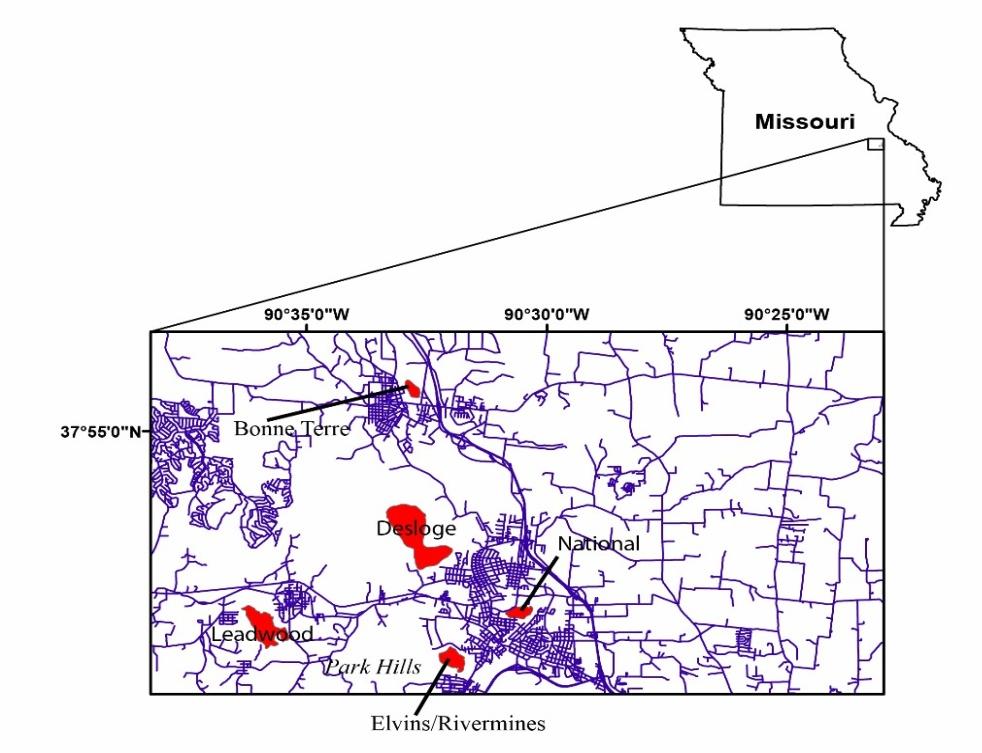
 DownLoad:
DownLoad: 